Wideband-Narrowband Switchable Tapered Slot Antenna for Breast Cancer Diagnosis and Treatment
Abstract
1. Introduction
2. Design of the Proposed Frequency Switchable Tapered Slot Antenna
2.1. Design of the Wideband Tapered Slot Antenna
2.2. Design of the Narrowband Resonator
2.3. Frequency Switchable Tapered Slot Antenna with Meander Line Resonator
3. Simulation and Measurement Results
4. Discussion
Author Contributions
Funding
Institutional Review Board Statement
Informed Consent Statement
Data Availability Statement
Acknowledgments
Conflicts of Interest
References
- American Cancer Society. Cancer Facts & Figures 2014; American Cancer Society: Atlanta, GA, USA, 2014. [Google Scholar]
- Liu, Q.H.; Zhang, Z.Q.; Wang, T.T.; Bryan, J.A.; Ybarra, G.A.; Nolte, L.W.; Joines, W.T. Active Microwave Imaging. I. 2-D Forward and Inverse Scattering Methods. IEEE Trans. Microw. Theory 2002, 50, 123–133. [Google Scholar]
- Islam, M.; Islam, M.T.; Samsuzzaman, M.; Faruque, M.R.I.; Misran, N.; Mansor, M.F. A miniaturized antenna with negative index metamaterial based on modified SRR and CLS unit cell for UWB microwave imaging applications. Materials 2015, 8, 392–407. [Google Scholar] [CrossRef] [PubMed]
- Bahramiabarghouei, H.; Porter, E.; Santorelli, A.; Gosselin, B.; Popović, M.; Rusch, L.A. Flexible 16 antenna array for microwave breast cancer detection. IEEE Trans. Biomed. Eng. 2015, 62, 2516–2525. [Google Scholar] [CrossRef] [PubMed]
- Abbosh, A.; Crozier, S. Strain imaging of the breast by compression microwave imaging. IEEE Antennas Wirel. Propag. Lett. 2010, 9, 1229–1232. [Google Scholar] [CrossRef]
- Bourqui, J.; Okoniewski, M.; Fear, E.C. Balanced antipodal Vivaldi antenna with dielectric director for near-field microwave imaging. IEEE Trans. Propag. 2010, 58, 2318–2326. [Google Scholar] [CrossRef]
- Islam, M.T.; Mahmud, M.Z.; Islam, M.T.; Kibria, S.; Samsuzzaman, M. A low cost and portable microwave imaging system for breast tumor detection using UWB directional antenna array. Sci. Rep. 2019, 9, 1–13. [Google Scholar] [CrossRef] [PubMed]
- Zastrow, E.; Hagness, S.C.; Van Veen, B.D. 3D computational study of non-invasive patient-specific microwave hyperthermia treatment of breast cancer. Phys. Med. Bio. 2010, 55, 3611. [Google Scholar] [CrossRef] [PubMed]
- Choi, W.C.; Kim, K.J.; Kim, J.; Yoon, Y.J. Compact microwave radiator for improving heating uniformity in hyperthermia system IEEE Antennas Wireless. Propag. Lett. 2014, 13, 1345–1348. [Google Scholar]
- Kim, K.J.; Choi, W.C.; Yoon, Y.J. Branched dipole array applicator for superficial hyperthermia system. In Proceedings of the 2012 6th European Conference on Antennas and Propagation (EUCAP), Prague, Czech Republic, 26–30 March 2012; pp. 3659–3663. [Google Scholar]
- He, X.; Geyi, W.; Wang, S. A hexagonal focused array for microwave hyperthermia: Optimal design and experiment. IEEE Antennas Wireless. Propag. Lett. 2015, 15, 56–59. [Google Scholar] [CrossRef]
- Nachouane, H.; Najid, A.; Riouch, F.; Tribak, A. Electronically reconfigurable filtenna for cognitive radios. Microw. Opt. Technol. Lett. 2016, 59, 399–404. [Google Scholar] [CrossRef]
- Saha, C.; Siddiqui, J.Y.; Freundorfer, A.P.; Shaik, L.A.; Antar, Y.M.M. Active Reconfigurable Ultra-Wideband Antenna with Complementary Frequency Notched and Narrowband Response. IEEE Access 2020, 8, 100802–100809. [Google Scholar] [CrossRef]
- Natani, P.; Shaik, L.A.; Saha, C.; Siddiqui, J.Y.; Antar, Y.M.M. Dual frequency notched coplanar tapered slot antenna using split ring resonators on modified slotline. In Proceedings of the 2016 17th International Symposium on Antenna Technology and Applied Electromagnetics (ANTEM), Montréal, QC, Canada, 10–13 July 2016; pp. 1–3. [Google Scholar]
- Chagharvand, S.; Hamid, M.R.; Kamarudin, M.R.; Ghanem, F. Reconfigurable multiband tapered slot antenna. Microw. Opt. Technol. Lett. 2015, 57, 2182–2186. [Google Scholar] [CrossRef]
- Hamid, M.R.; Gardner, P.; Hall, P.S.; Ghanem, F. Switched-band Vivaldi antenna. IEEE Trans. Antennas Propag. 2011, 59, 1472–1480. [Google Scholar] [CrossRef]
- Abutarboush, H.F.; Nilavalan, R.; Cheung, S.W.; Nasr, K.M.; Peter, T.; Budimir, D.; Al-Raweshidy, H. A reconfigurable wideband and multiband antenna using dual-patch elements for compact wireless devices. IEEE Trans. Antennas Propag. 2011, 60, 36–43. [Google Scholar] [CrossRef]
- FCC Rules and Regulations 47 CFR Part 95, Subparts E (95.601-95.673) and I (95.1201-95.1219) Personal Radio Services. November 2002. Available online: https://www.law.cornell.edu/cfr/text/47/part-95 (accessed on 17 March 2021).
- Ebnabbasi, K.; Busuioc, D.; Birken, R.; Wang, M. Taper design of Vivaldi and co-planar tapered slot antenna (TSA) by Chebyshev transformer. IEEE Trans. Antennas Propag. 2012, 60, 2252–2259. [Google Scholar] [CrossRef]
- Zinieris, M.M.; Sloan, R.; Davis, L.E. A broadband microstrip-to-slot-line transition. Microw. Opt. Technol. Lett. 1998, 18, 339–342. [Google Scholar] [CrossRef]
- Shuppert, B. Microstrip/slotline transitions: Modeling and experimental investigation. IEEE Trans. Microw. Theory 1988, 36, 1272–1282. [Google Scholar] [CrossRef]
- Ko, D.O.; Woo, J.M. Design of a small radio frequency identification tag antenna using a corrugated meander line applicable to a drug runout sensor system. J. Electromagn. Eng. Sci. 2018, 18, 7–12. [Google Scholar] [CrossRef]
- Das, A.; Dhar, S.; Gupta, B. Lumped circuit model analysis of meander line antennas. In Proceedings of the 2011 11th Mediterranean Microwave Symposium (MMS), Yasmine Hammamet, Tunisia, 8–10 September 2011; pp. 21–24. [Google Scholar]
- Best, S.R.; Morrow, J.D. Limitations of inductive circuit model representations of meander line antennas. In Proceedings of the IEEE Antennas and Propagation Society International Symposium. Digest. Held in conjunction with: USNC/CNC/URSI North American Radio Sci. Meeting (Cat. No. 03CH37450), Columbus, OH, USA, 22–27 June 2003; Volume 1, pp. 852–855. [Google Scholar]


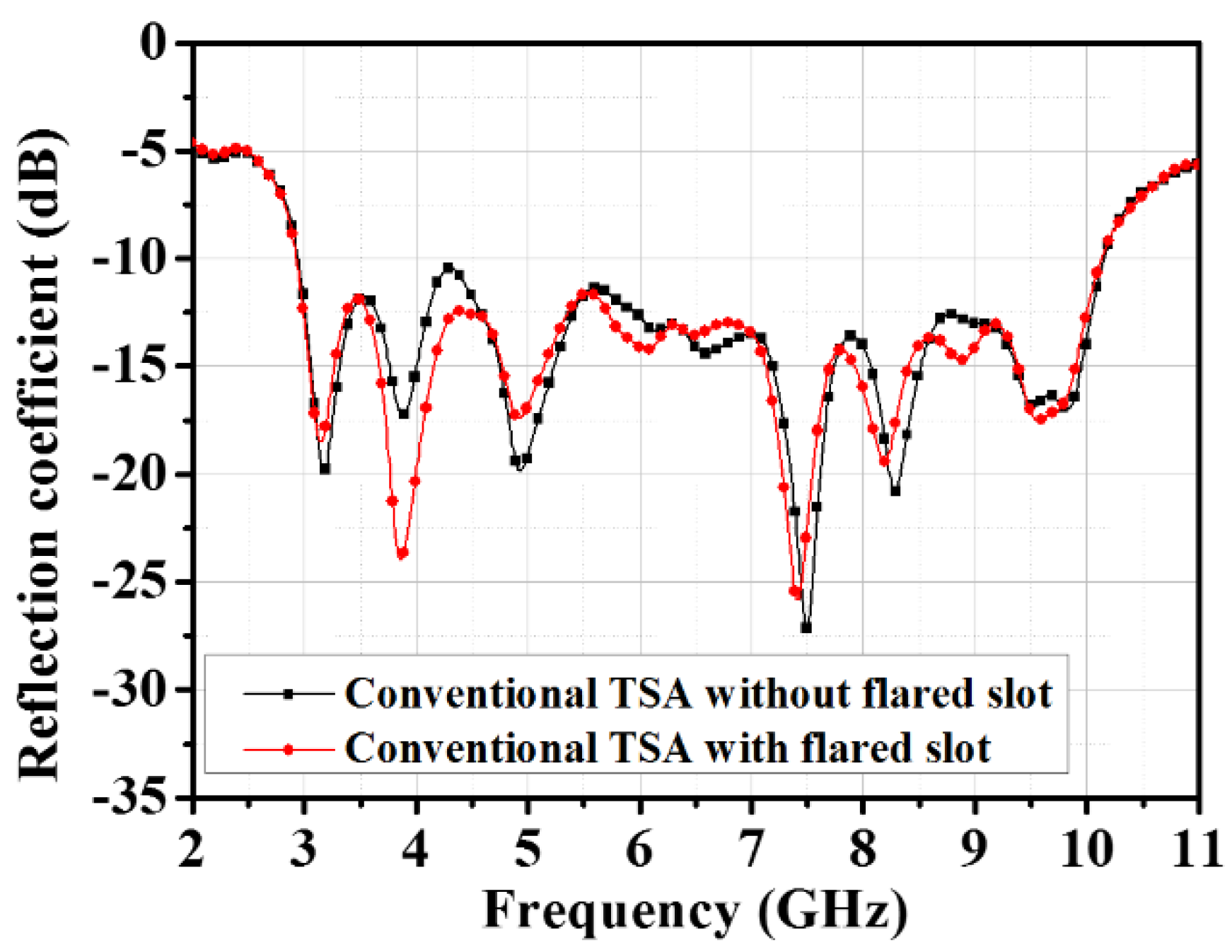
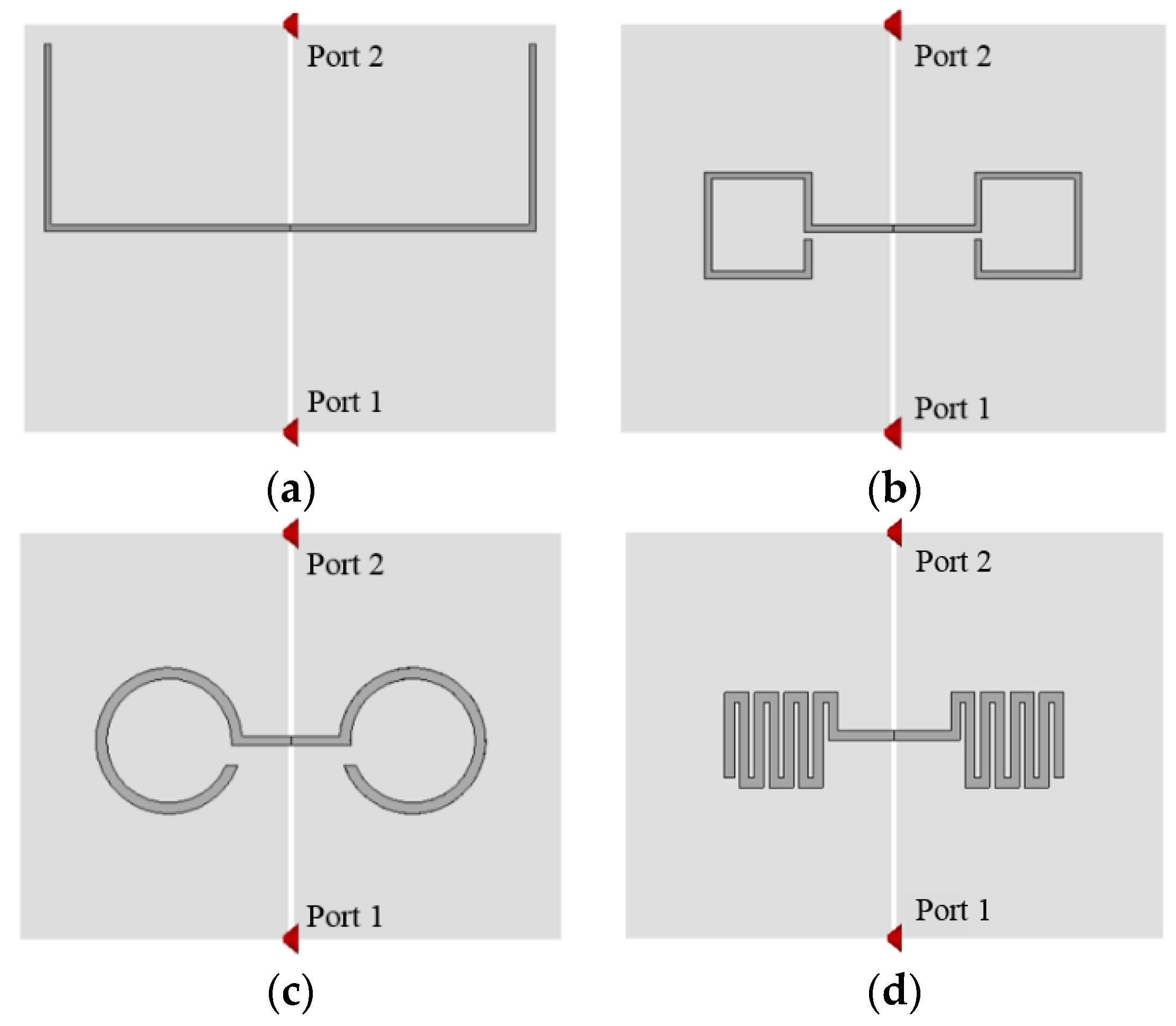
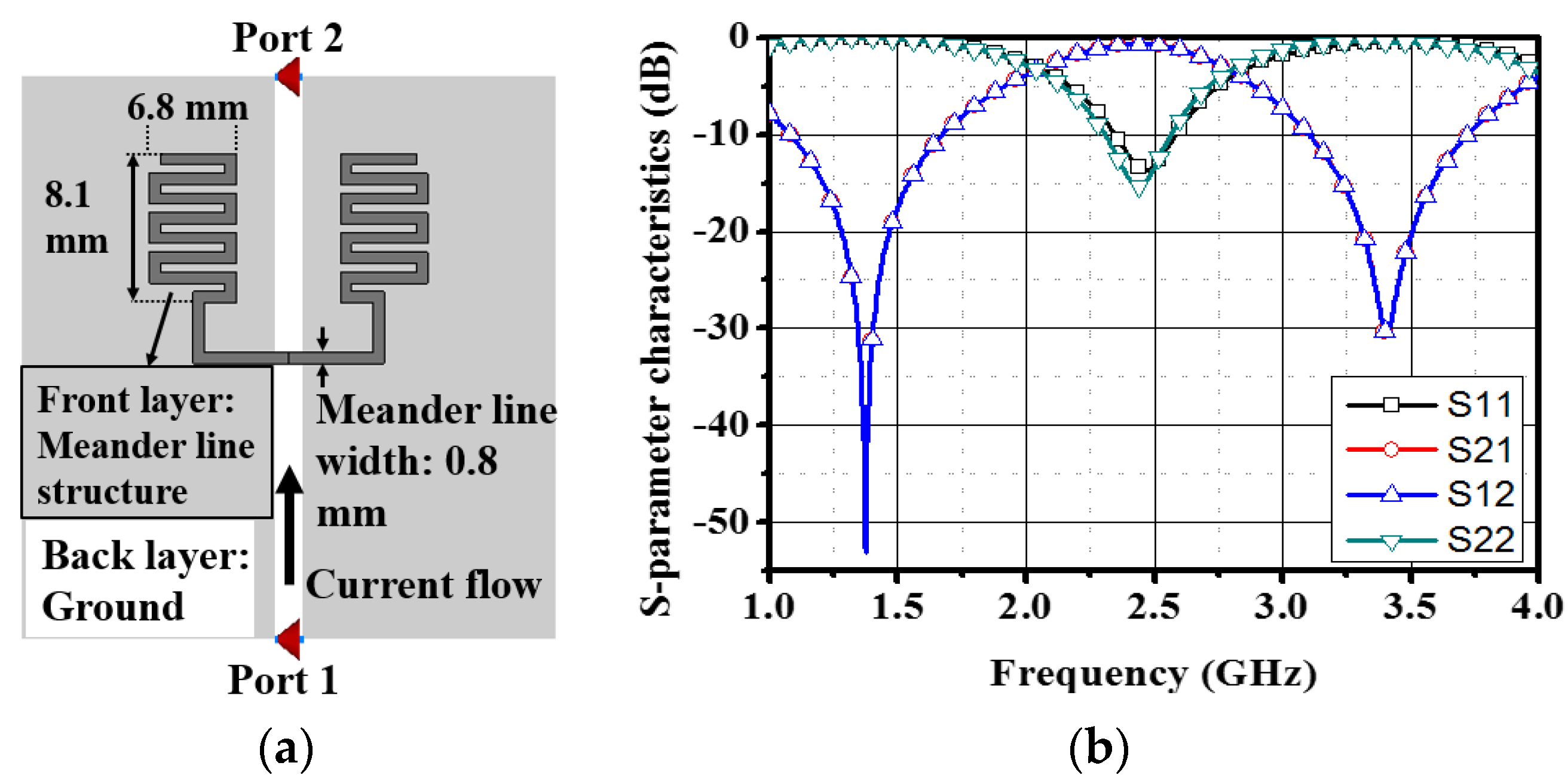

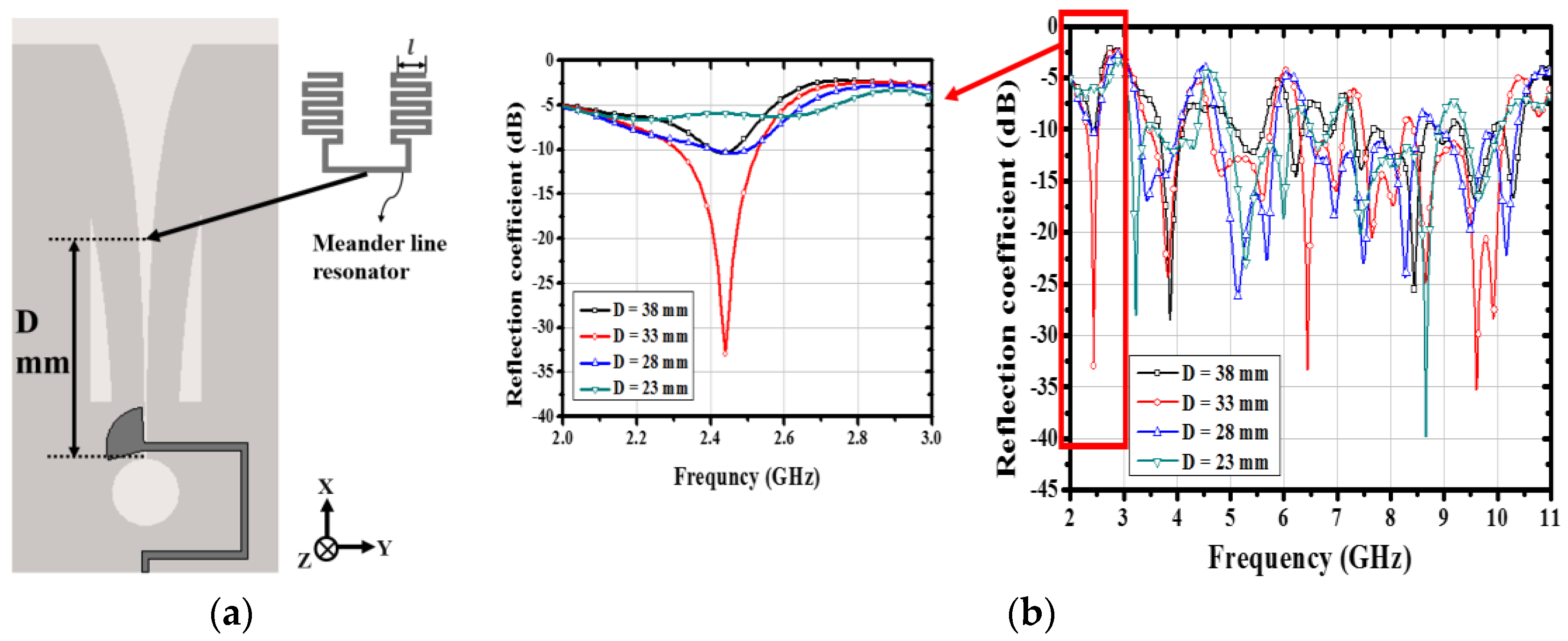

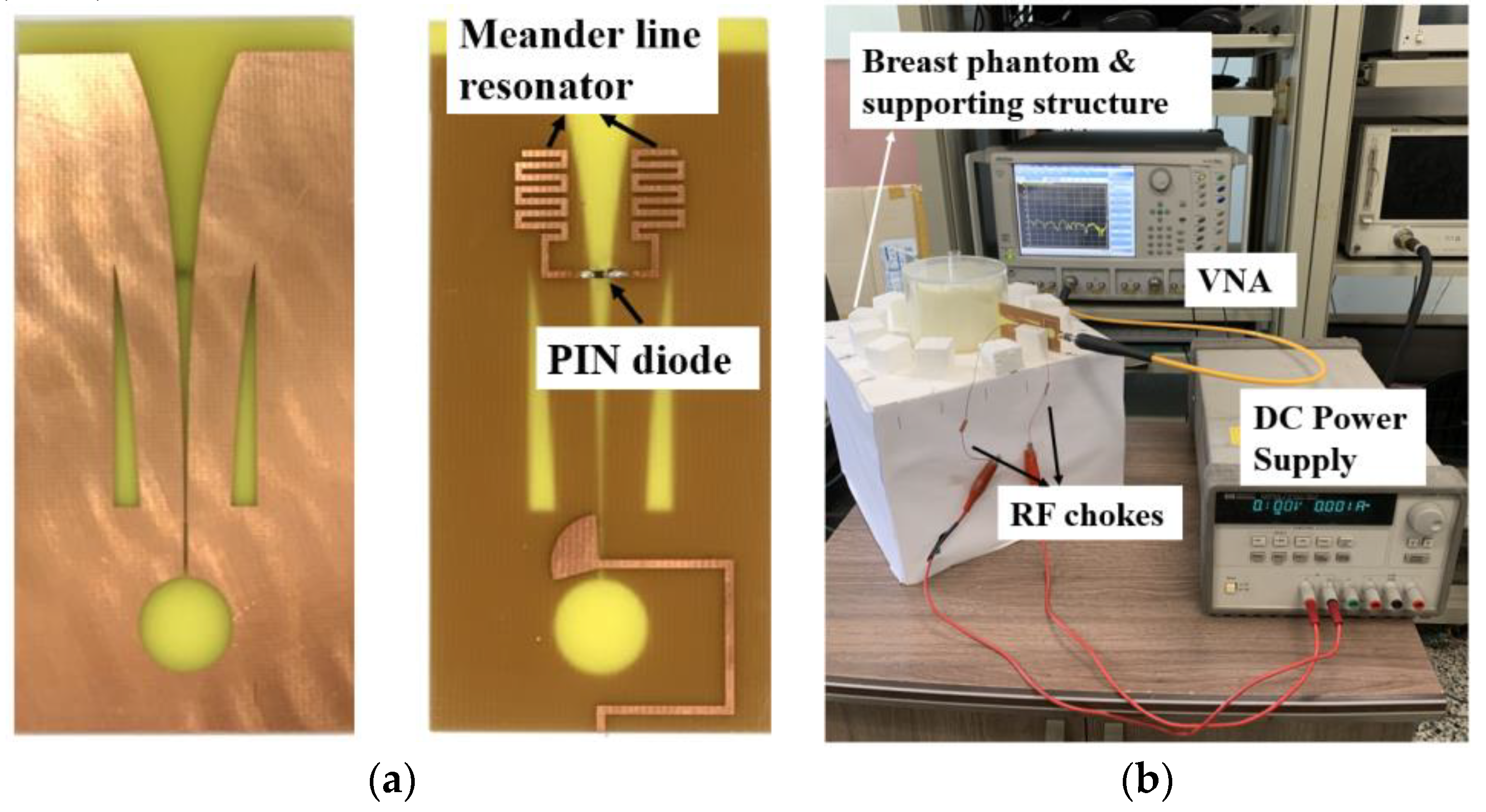
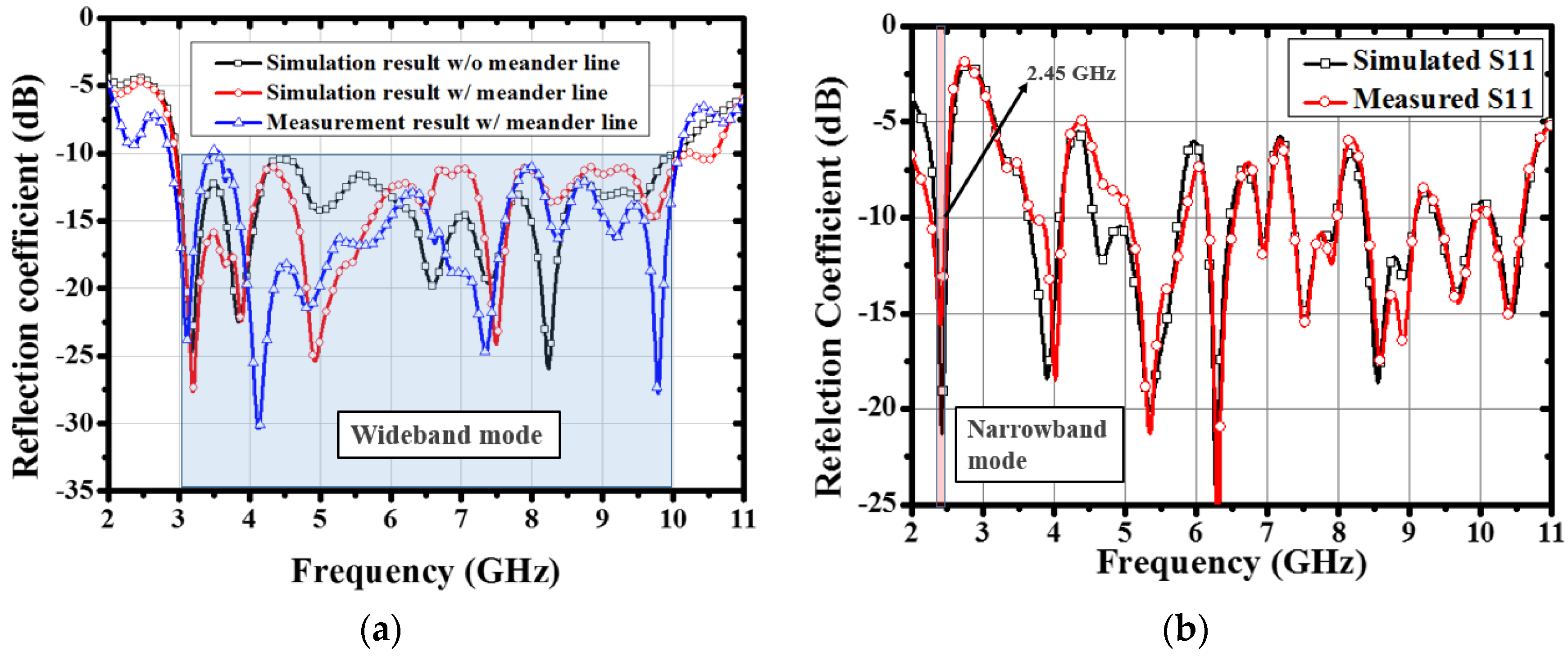
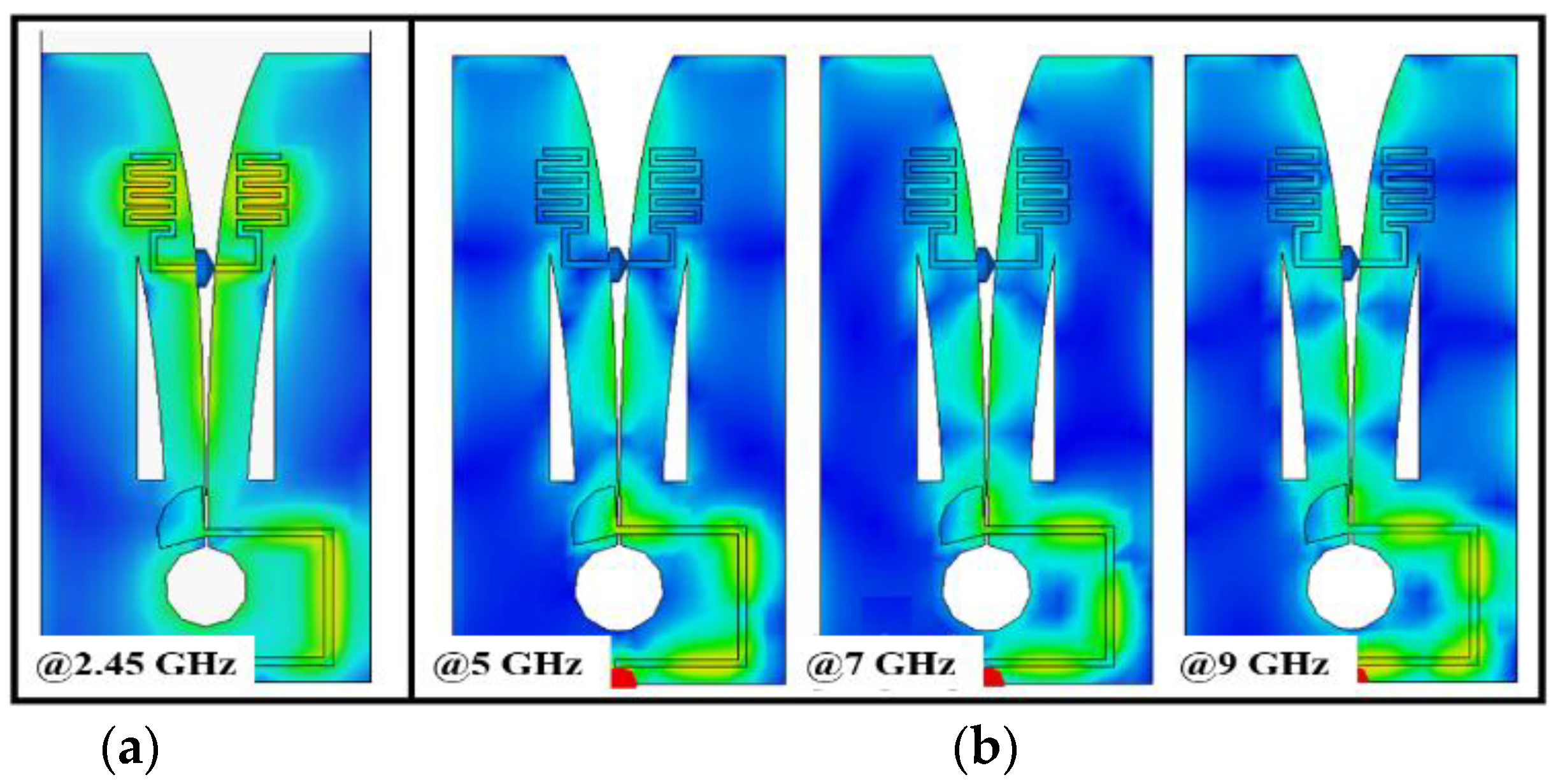
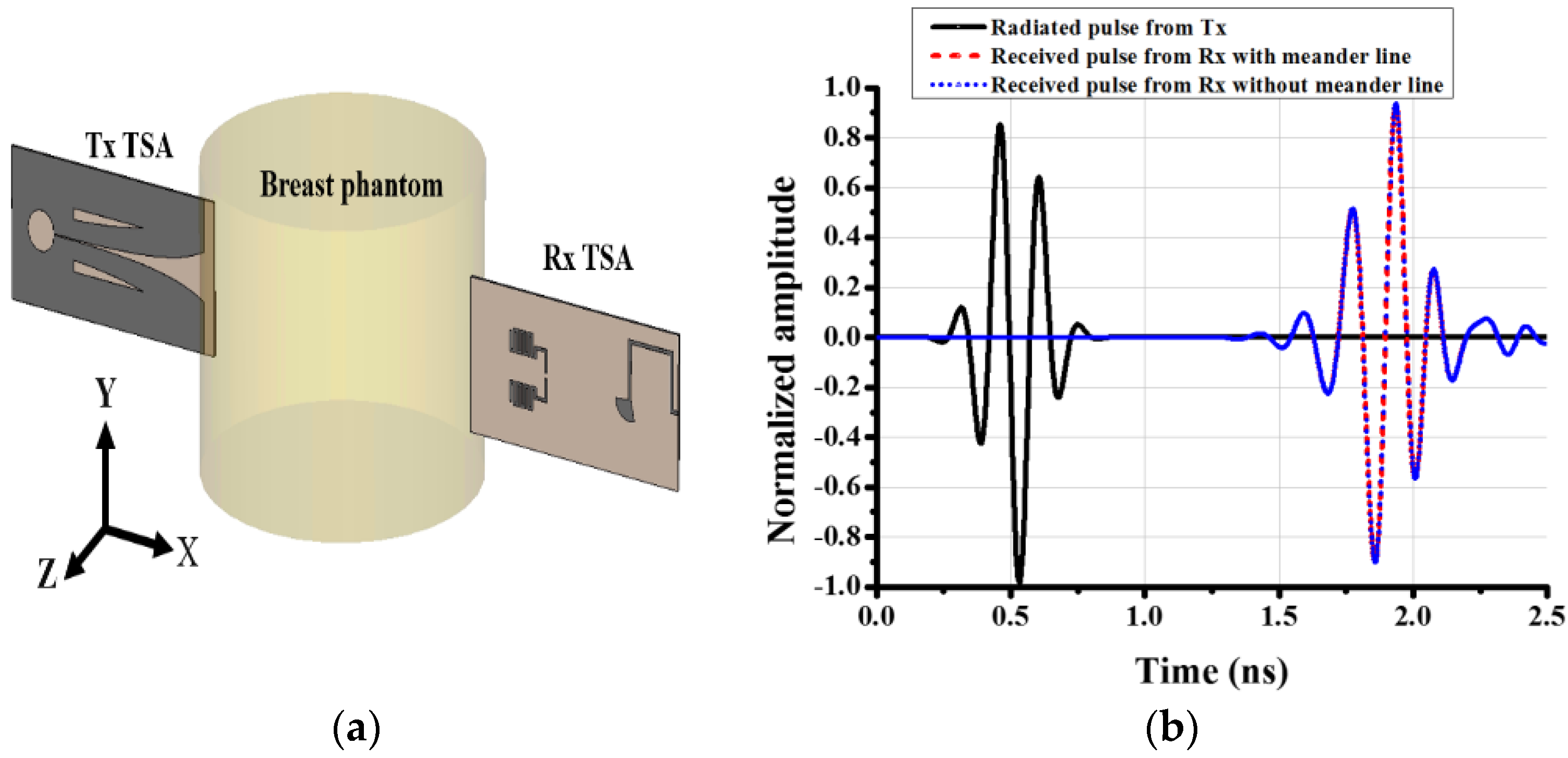
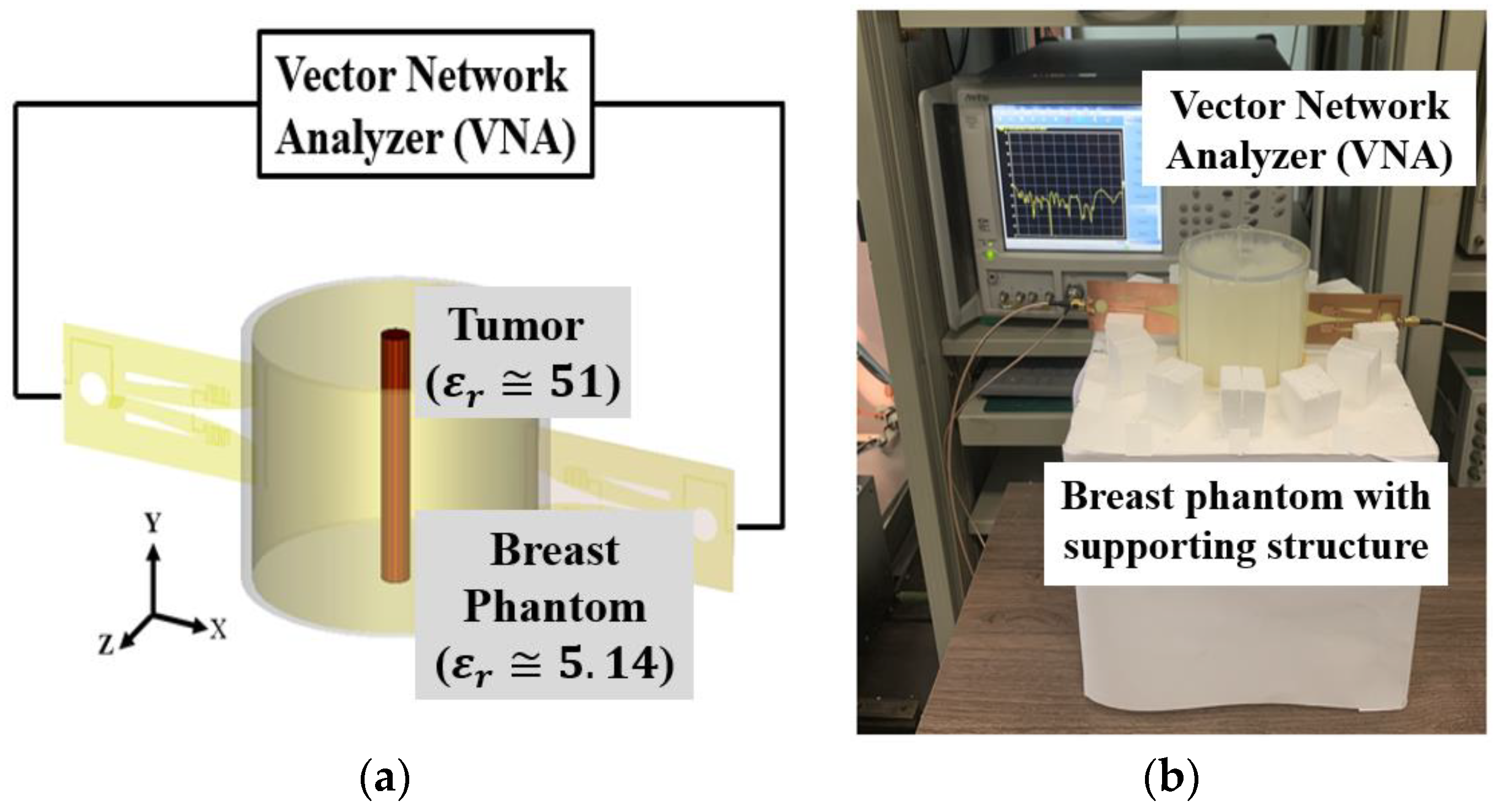
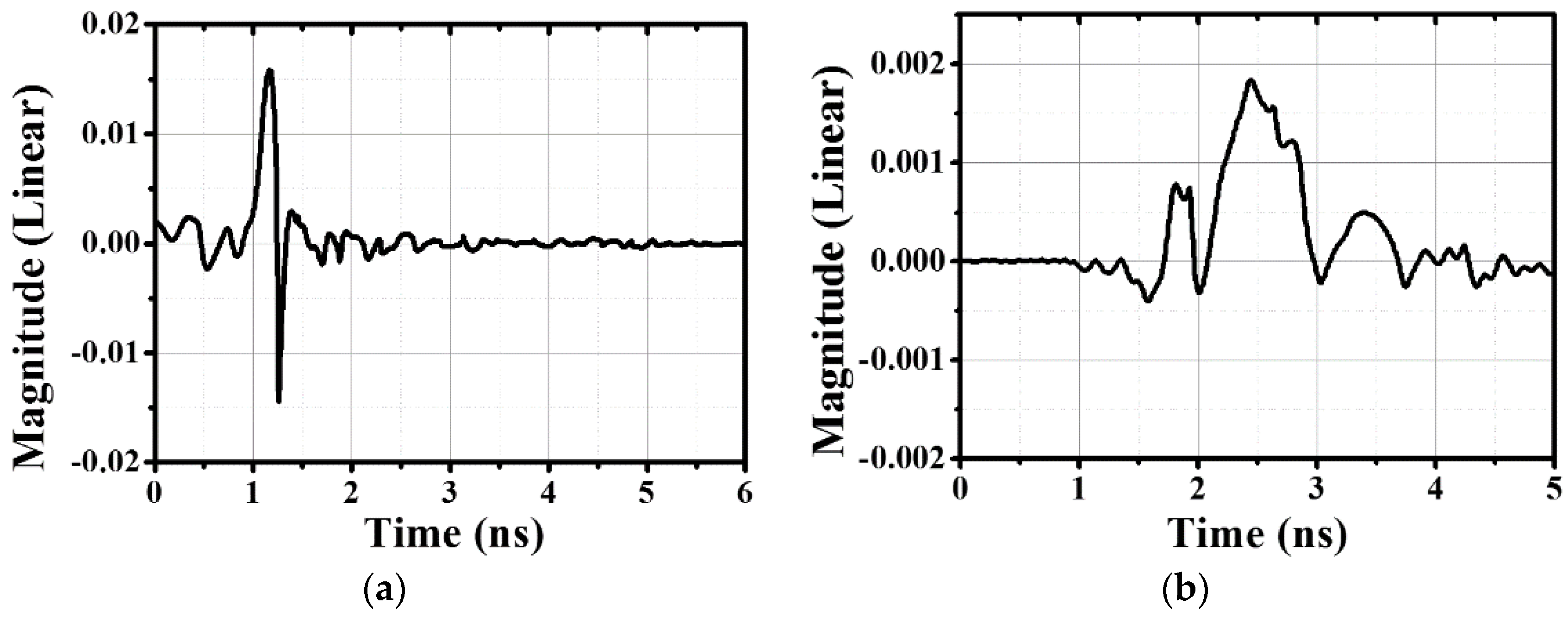
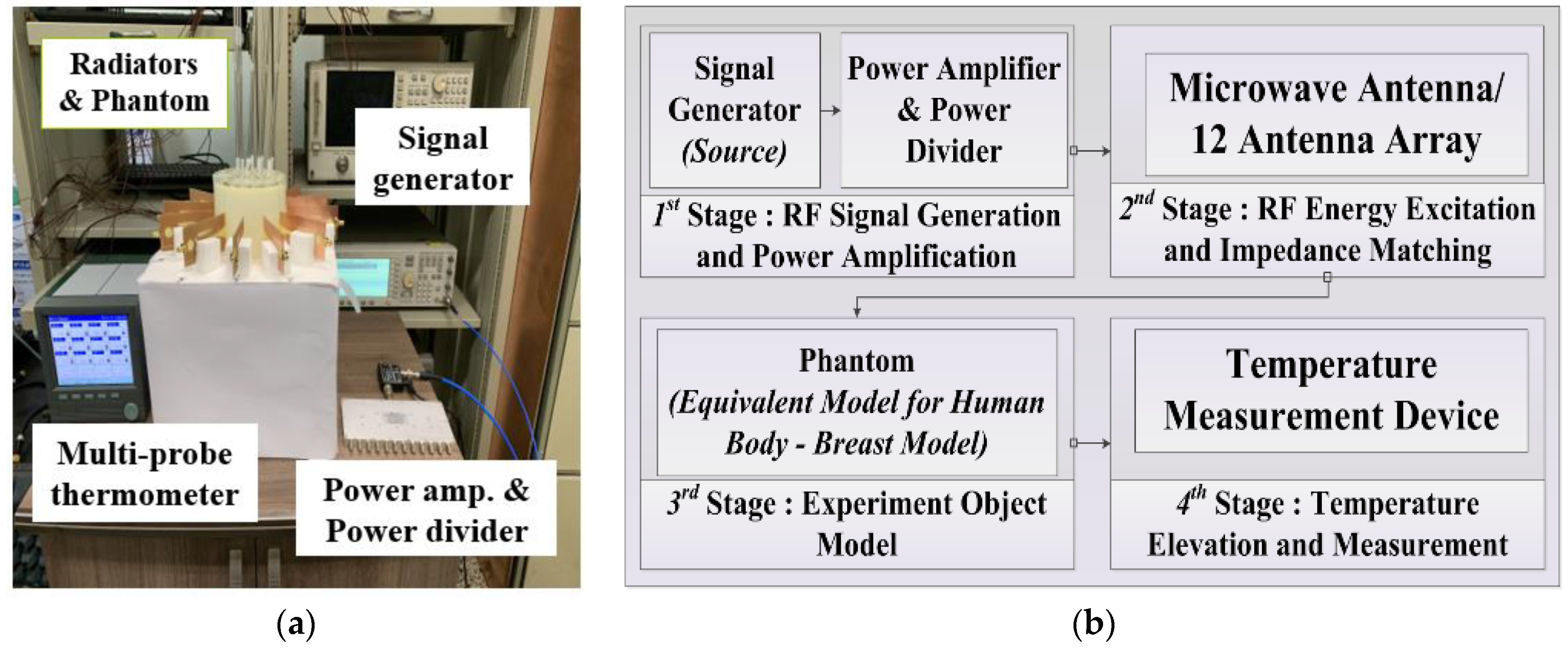
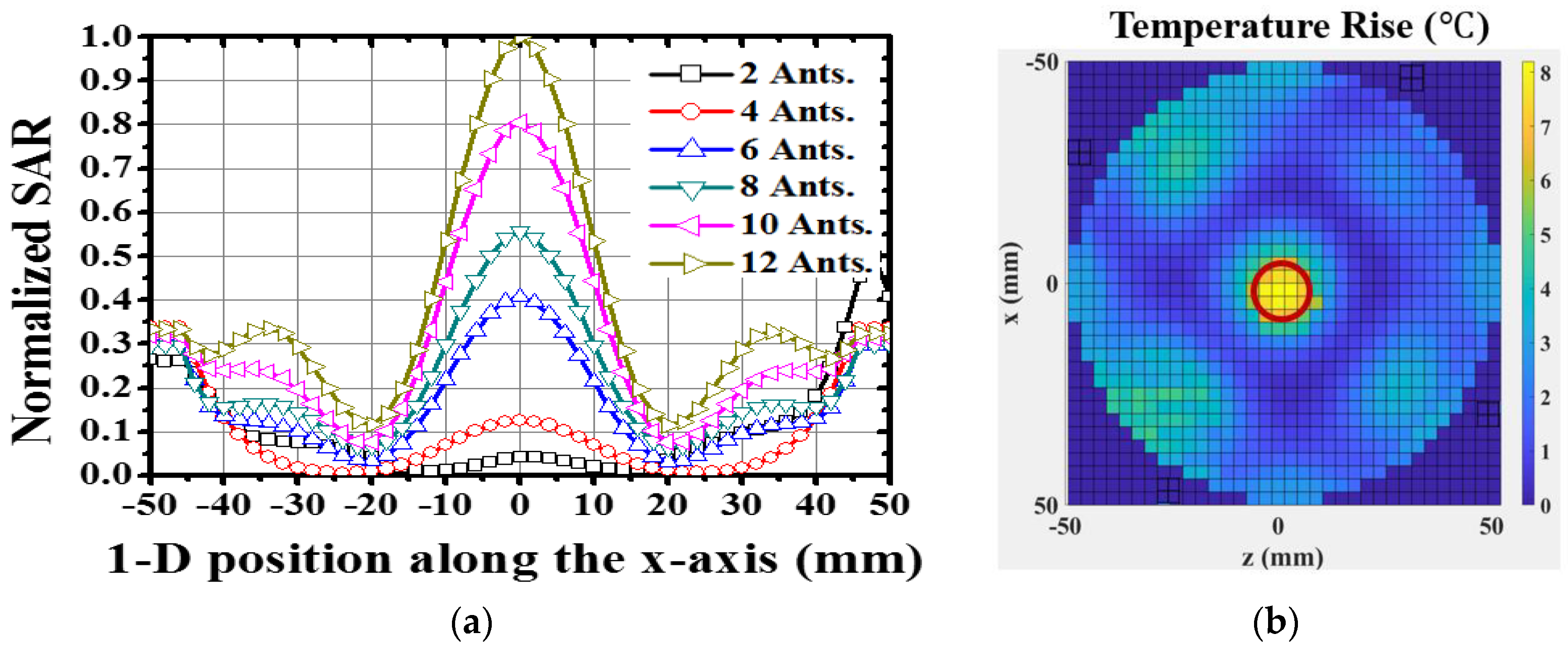
| Shapes | Insertion Loss (S21), dB | |
|---|---|---|
| Bent dipole | −1.71 | 15 mm × 16.25 mm (0.25× 0.27) |
| Square ring | −1.67 | 10.5 mm × 10.5 mm (0.178× 0.178) |
| Round ring | −1.65 | 7.8 mm × 7.8 mm (0.132× 0.132) |
| Meander line | −1.65 | 7.6 mm × 7.3 mm (0.129× 0.124) |
| Ref. | Wideband Antenna Type and Size | No. of Switching Elements | Shape for Narrowband | Frequency Range—Wideband and Narrowband (GHz) | |
|---|---|---|---|---|---|
| [12] | Uniplanar monopole antenna (60 mm 80 mm) | 2 PIN diodes 2 varactors | Ring slot resonators | 0.230.23 | (WB)1.33–6, (NB) 2.55, 2.6, 2.8, 3.2 |
| [13] | CPW fed circular monopole (50 mm 47 mm) | 2 PIN diodes | Split ring resonators | Low band: 0.150.15 High band: 0.140.14 | (WB)2.5–11, (NB) 6.02, 9.18 |
| [14] | TSA (35.8 mm 54 mm) | 2 PIN diodes for frequency switching | Split ring resonators | 0.340.34 | (WB) 3.1–12, (NB) 6.35 |
| [15] | TSA (166 mm 141 mm) | 4 PIN diodes | C-, T-shaped slots | C-shape: 0.5 T-shape: 1.85 | (WB) 1.04–3.76, (NB) 0.97–1.24, 1.63–2.08, 2.64–3.71 |
| [16] | Vivaldi antenna (144 mm 120 mm) | 6 PIN diodes | Ring slot resonators | Low band: 0.160.16 Mid band: 0.320.32 High band: 0.160.16 | (WB) 1–3.2, (NB) 1.1, 2.25, 3.1 |
| [17] | Patch antenna (50 mm 50 mm) | 2 PIN diodes | C-shaped slots | Low band: 0.630.49 High band: 0.860.61 | (WB) 5–7, (NB) 5, 5.5, 6.2 |
| This work | TSA (40 mm 80 mm) | 1 PIN diode | Meander line | 0.110.13 | (WB) 3.1–10, (NB) 2.45 |
Publisher’s Note: MDPI stays neutral with regard to jurisdictional claims in published maps and institutional affiliations. |
© 2021 by the authors. Licensee MDPI, Basel, Switzerland. This article is an open access article distributed under the terms and conditions of the Creative Commons Attribution (CC BY) license (https://creativecommons.org/licenses/by/4.0/).
Share and Cite
Lim, S.; Yoon, Y.J. Wideband-Narrowband Switchable Tapered Slot Antenna for Breast Cancer Diagnosis and Treatment. Appl. Sci. 2021, 11, 3606. https://doi.org/10.3390/app11083606
Lim S, Yoon YJ. Wideband-Narrowband Switchable Tapered Slot Antenna for Breast Cancer Diagnosis and Treatment. Applied Sciences. 2021; 11(8):3606. https://doi.org/10.3390/app11083606
Chicago/Turabian StyleLim, Seonho, and Young Joong Yoon. 2021. "Wideband-Narrowband Switchable Tapered Slot Antenna for Breast Cancer Diagnosis and Treatment" Applied Sciences 11, no. 8: 3606. https://doi.org/10.3390/app11083606
APA StyleLim, S., & Yoon, Y. J. (2021). Wideband-Narrowband Switchable Tapered Slot Antenna for Breast Cancer Diagnosis and Treatment. Applied Sciences, 11(8), 3606. https://doi.org/10.3390/app11083606






